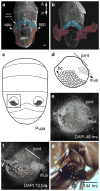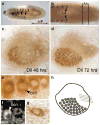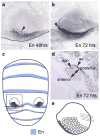Partial co-option of the appendage patterning pathway in the development of abdominal appendages in the sepsid fly Themira biloba
- PMID: 20182886
- PMCID: PMC4169174
- DOI: 10.1007/s00427-010-0319-3
Partial co-option of the appendage patterning pathway in the development of abdominal appendages in the sepsid fly Themira biloba
Abstract
The abdominal appendages on male Themira biloba (Diptera: Sepsidae) are complex novel structures used during mating. These abdominal appendages superficially resemble the serially homologous insect appendages in that they have a joint and a short segment that can be rotated. Non-genital appendages do not occur in adult pterygote insects, so these abdominal appendages are novel structures with no obvious ancestry. We investigated whether the genes that pattern the serially homologous insect appendages have been co-opted to pattern these novel abdominal appendages. Immunohistochemistry was used to determine the expression patterns of the genes extradenticle (exd), Distal-less (Dll), engrailed (en), Notch, and the Bithorax Complex in the appendages of T. biloba during pupation. The expression patterns of Exd, En, and Notch were consistent with the hypothesis that a portion of the patterning pathway that establishes the coxopodite has been co-opted to pattern the developing abdominal appendages. However, Dll was only expressed in the bristles of the developing appendages and not the proximal-distal axis of the appendage itself. The lack of Dll expression indicates the absence of a distal domain of the appendage suggesting that sepsid abdominal appendages only use genes that normally pattern the base of segmental appendages.
Figures






Similar articles
-
Evolution of novel abdominal appendages in a sepsid fly from histoblasts, not imaginal discs.Evol Dev. 2007 Jul-Aug;9(4):347-54. doi: 10.1111/j.1525-142X.2007.00171.x. Evol Dev. 2007. PMID: 17651359
-
Evolution of insect abdominal appendages: are prolegs homologous or convergent traits?Dev Genes Evol. 2001 Oct;211(10):486-92. doi: 10.1007/s00427-001-0182-3. Dev Genes Evol. 2001. PMID: 11702198
-
Comparative analysis reveals the complex role of histoblast nest size in the evolution of novel insect abdominal appendages in Sepsidae (Diptera).BMC Evol Biol. 2018 Oct 10;18(1):151. doi: 10.1186/s12862-018-1265-3. BMC Evol Biol. 2018. PMID: 30314458 Free PMC article.
-
Insect appendages and comparative ontogenetics.Dev Biol. 2005 Oct 1;286(1):57-77. doi: 10.1016/j.ydbio.2005.07.006. Dev Biol. 2005. PMID: 16112665 Review.
-
Proximo-distal development in the legs of Drosophila.Int J Dev Biol. 1998;42(3):345-52. Int J Dev Biol. 1998. PMID: 9654018 Review.
Cited by
-
CRISPR/Cas9 deletions in a conserved exon of Distal-less generates gains and losses in a recently acquired morphological novelty in flies.iScience. 2018 Dec 21;10:222-233. doi: 10.1016/j.isci.2018.11.036. Epub 2018 Dec 1. iScience. 2018. PMID: 30553946 Free PMC article.
-
Metamorphic labral axis patterning in the beetle Tribolium castaneum requires multiple upstream, but few downstream, genes in the appendage patterning network.Evol Dev. 2014 Mar;16(2):78-91. doi: 10.1111/ede.12066. Evol Dev. 2014. PMID: 24617987 Free PMC article.
-
Single locus affects embryonic segment polarity and multiple aspects of an adult evolutionary novelty.BMC Biol. 2010 Aug 26;8:111. doi: 10.1186/1741-7007-8-111. BMC Biol. 2010. PMID: 20796293 Free PMC article.
-
Evolution of sex-specific traits through changes in HOX-dependent doublesex expression.PLoS Biol. 2011 Aug;9(8):e1001131. doi: 10.1371/journal.pbio.1001131. Epub 2011 Aug 23. PLoS Biol. 2011. PMID: 21886483 Free PMC article.
-
Evolutionary history of the recruitment of conserved developmental genes in association to the formation and diversification of a novel trait.BMC Evol Biol. 2012 Feb 15;12:21. doi: 10.1186/1471-2148-12-21. BMC Evol Biol. 2012. PMID: 22335999 Free PMC article.
References
-
- Abouheif E. Developmental genetics and homology: a hierarchical approach. TREE. 1997;12:405–408. - PubMed
-
- Abzhanov A, Kaufman TC. Homologs of Drosophila appendage genes in the patterning of arthropod limbs. Dev Biol. 2000;227:673–689. - PubMed
-
- Abu-Shaar M, Mann RS. Generation of multiple antagonistic domains along the proximodistal axis during Drosophila leg development. Development. 1998;125:3821–3830. - PubMed
-
- Angelini DR, Kauffman TC. Insect appendages and comparative ontogenetics. Dev Biol. 2005;286:57–77. - PubMed
-
- Artavanis-Tsakonas S, Matsuno K, Fortini ME. Notch signaling. Science. 1995;268:225–232. - PubMed
Publication types
MeSH terms
Substances
Grants and funding
LinkOut - more resources
Full Text Sources
Research Materials

